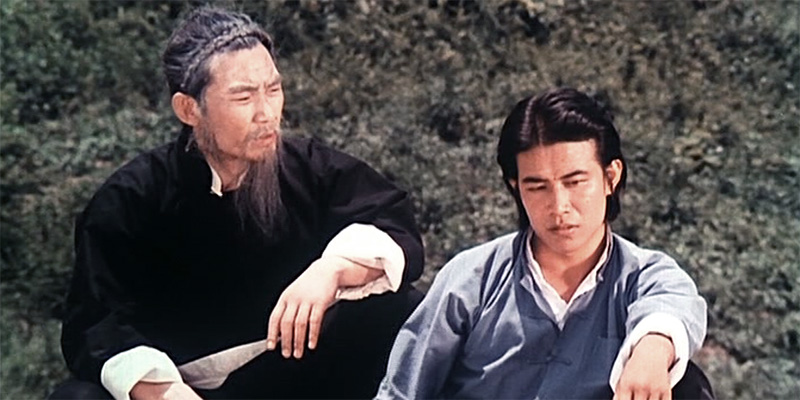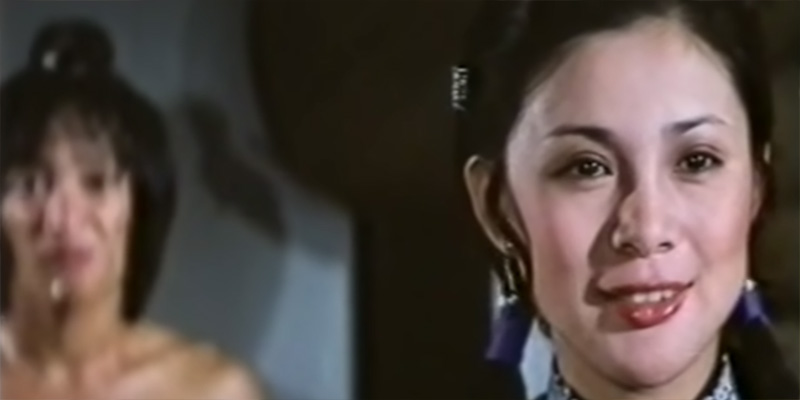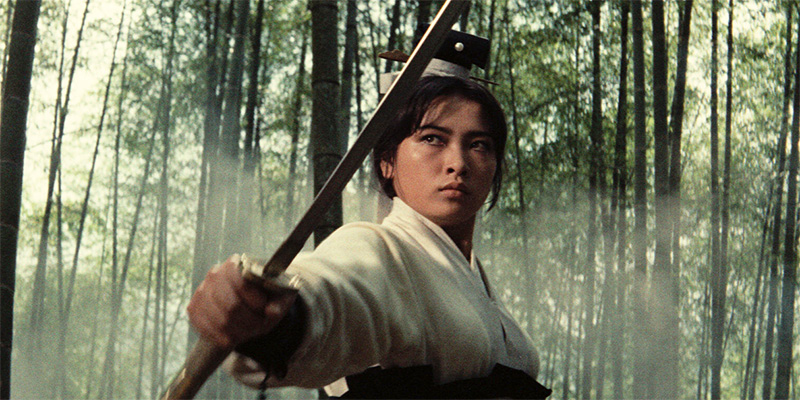As part of Old School Easter, we opened up the doors at FEF towers to allow you, the readers, to submit your own content. Below you’ll find two of the reviews that we received, and we would like to express our extreme thanks to everyone who participated.
The Himalayan (1976)
Starring: Angela Mao, Chan Sing, Tan Tao-Liang, Guan Shan, Ling Hon
Action Directors: Han Ying-Chieh, Sammo Hung
Director: Huang Feng

Like Tibet, where this film is set, it is difficult to categorise The Himalayan. An action film without much action. An Angela Mao film without much Angela Mao.
The first hour involves the Machiavellian machinations of Kao Chu (played with relish by Chan Sing looking like the bastard love child of Charles Bronson and Yuen Wah). Kao worms his way into the powerful Cheng family through trickery and deceit; and thereafter must indulge in an escalating number of murders in order to secure his control over the Cheng fortune. The second hour focuses on Cheng’s daughter (Angela Mao) and man-servant (Tan Tao-liang AKA Flash Legs) thinking about getting revenge, planning to get revenge, preparing to get revenge, then finally getting revenge.
The Himalayan is an interesting but not wholly satisfying film. It is interesting because of its visual spice – the colour and customs of Chinese ethnic minorities (Nepal playing Tibet), the striking architecture and landscapes, and the surprising dashes of naughty nudity. It is also unusual in that the fighting feels embedded within a plot, rather than the old school preference for a plot embedded in fighting. Yet it is in this last respect that it lets its audience down.
The film foregrounds the story of Kao’s intrigue and ascendency. But there is little to impede him, there is insufficient detail or nuance to care about the characters, and the intrigue is not very intriguing. In a typical kung fu film this would not matter because there may be a killer fight just round the corner, or through the archway and in the courtyard.
There are occasional skirmishes along the way, but there are no extended fight sequences until the final conflict. Moreover, the fights are short, stiff and often unimaginative. Given the growing sense of power in Sammo’s choreography from this period (consider how impressive he made even George Lazenby look in Stoner, 1974), one must assume that old-timer Han Ying-hsieh is in charge for most of the fighting.
The final battle between Mao, Chan, and Legs is the only encounter of note. Here the Tiger Claw vs. Mizong-style fighters are allowed to build up momentum, show force, and display some impressive kicking combinations as well as a surprising instance of death-by-spitting.
Given the sterling quality of previous Huang Feng-Angela Mao-Sammo Hung collaborations (check out Hapkido, 1972 or When Taekwondo Strikes, 1973), I found this effort disappointing though not disastrous. It dares to forego the repeated adrenaline kicks of old school movies, but forgets to replace them with an engaging or well-paced story.
Reviewed by Bryde Baker
The Crane Fighter (1979)
AKA: The Crane Fighters, Champ of Champs
Starring: Chia Ling (Judy Lee), Raymond Lui, Kam Kong, Ting Wa-Chung, Chuan Yuan
Action Directors: Raymond Lui, So Kwok-Leung
Director: Raymond Lui

There’s something about the universe that likes to do things in three’s, especially in religion. There are three Abrahamic religions: Christianity, Judaism, and Islam. Christians worship the Trinity: Three Gods in purpose, but not in body. Catholics believe in three realms in the afterlife: Heaven, Hell, and the Purgatory. Christ received three gifts from the wise men. Buddhists take refuge in the Three Jewels. Hinduism has its Trimurti: Brahma, Vishnu, and Shiva. The Norsemen believed that the Yggdrasil, the world tree, had three roots. Wiccans believe in the Triple Goddess. The list goes on. Taking the idea of three as an important religious number and applying it to kung fu movies, let’s take a look at the three most important kung fu actresses.
So, if one were to ask me about the Holy Trinity of Kung Fu Divas, I wouldn’t think twice in stating that the Trinity would be composed of: Angela Mao Ying, Polly Shang Kwan Ling Feng, and Chia Ling, aka Judy Lee. Those three women best represent what is beautiful and wonderful about kung-fu kicking women beating up their male counterparts with a flick of the wrist and a boot to the noggin. Now, this declaration goes way beyond their skills and contemplates their personalities as well. Both Cheng Pei-Pei and Hsu Feng came before those three (or at least two of them), but their careers were largely limited to wuxia swordplay films and their hand-to-hand skills were rather limited. Other actresses like Hsia Kwan-Li and Sharon Yeung Pan-Pan were easily better acrobatic fighters than the Trifecta I’ve named, but the former never had a very expressive career and the latter sorely lacked the charisma of her predecessors. Angela, Polly and Judy embodied the physical and personality traits of the top female fighters, even though taken individually, they were rather different from each other.
Angela Mao Ying is often referred to as the “Female Bruce Lee” and with good reason. In addition to Angela’s natural beauty, the actress projected a smoldering intensity and possessed a no-nonsense gaze that few other female fighters before or since could come close to matching. She was endowed with a presence that could simultaneously strike fear into my heart while simultaneously making me want to drop to one knee and ask me to marry her (I say this is partial jest of course). Few people could making head-kicking as hypnotically graceful as Angela did during her career. Then there’s Polly Shang Kwan Ling Feng, the “Phoenix” to Bruce Lee’s “Dragon.” Polly could fight just as determinedly as Angela could, but her personality type was rather different. Angela was unmistakingly feminine in her carriage, while Polly was the tomboy–just one of the guys. If you were her non-martial artist friend, she’d gladly beat the hell out of anyone who messed with you (and would thoroughly enjoy it), and then the two of you would soon be back to telling jokes and laughing about the poor sucker whom she had just walloped. The martial arts styles she studied–karate, judo, and tae kwon do–are a reflection of her tomboyish nature, as those styles, especially karate, are more hard and direct than their Chinese counterparts. On the other hand, Angela Mao was both Peking Opera-trained and had a black belt in hapkido, both of which underscore her elegance and femininity, even when destroying her male counterparts.
The third member of the Trifecta of Female Old School Chopsockey Excellence was Chia Ling. Much like Angela Mao, Chia Ling trained in the Peking Opera and was well-renown on stage before receiving the invitation to act in films. Chia Ling occupied the middle ground between Angela’s intense persona and Polly’s fun-loving tomboy. Chia Ling was endowed with a heaping of charisma and a winning smile which usually overshadowed her intensity in the kung fu arena. Even when she was hell-bent on revenge, you couldn’t help but want to be close to her. Moreover, Chia was an excellent fighter and was capable of performing numerous styles in front of the camera, including drunken boxing–one of the only women to actually perform that style onscreen. But what really made Chia Ling stand out was her work ethic. From the interviews we’ve seen of her, she put her heart and soul into whatever was given to her. In her case, it just happened to be making martial arts movies. You admire her skills and know that she would be successful in any area she might have chosen for a career, because she’s willing to work hard for it. The Crane Fighters in many ways is the culmination of the woman’s talents and efforts.
The movie begins the way numerous films made since 1974 have: a contingent of Qing soldiers led by the Governor of Canton (Kam Kong of Snake and Crane Arts of Shaolin) attacking a group of laymen who survived the burning of the Shaolin Temple. After a bloody fight, only one Ming Patriot remains: Yang Su (Invincible Armour’s Chuen Yuen). Yang Su goes into hiding and becomes a bean curd seller, along with his daughter, Ping’er (Chia Ling, Against the Drunken Cat’s Paws and Queen Boxer). Ping’er is forbidden to learn martial arts, but she learns it anyway, namely the Crane Style of kung fu. After becoming a proficient martial artist, she teaches the art to her father’s assistant, Shao Wei (Ting Wa-Chung of Heroes of Shaolin and Peculiar Boxing Tricks and the Master), as well.
Of course, being a kung fu movie, her skills are bound to come out in the open sooner or later. That happens when a corrupt monk shows up at the door of some nobleman’s house and starts banging an annoying drum, demanding a donation of 100 taels. Shao Wei shows up and picks a fight with the monk, with Ping’er joining in on the fun of humiliating the charlatan. Yang Su is rather upset with his daughter for studying the martial arts against his wishes, but the sudden appearance an old Shaolin brother stops him from beating her to death for disobedience. Lucky her.
We’re then treated to another comic interlude (and genre cliché) in which a trio of lowlifes at a restaurant forces a poor singer and her father to sing lewd music for their pleasure. Ping’er arrives at the restaurant and challenges the men, but then a stranger (Raymond Lui, the film’s director) makes an appearance and beats the men to a pulp and forces them to sing like girls. He and Ping’er exchange lovey-dovey glances, but nothing really comes of this meeting.
Meanwhile, the humiliated monk from two paragraphs up complains to the village chief’s second-in-command, who sends the chief’s insane, hunchbacked son to teach Ping’er a lesson. The two fight until Yang Su interrupts, at which point the chief’s Yes Man says that Ping’er has to marry the crippled nutcase or the family will be thrown in jail. Of course, marrying the handicapped whackjob isn’t a very good option, so Yang Su contracts a matchmaker to find a husband for Ping’er. The best the matchmaker can come up with is a lazy opium smoker, whom Ping’er scares off by dressing like a prostitute (“She looks like the women you visit at the whorehouse, dad!”). At Shao Wei’s insistence, Yang Su sets up a martial arts tournament: whomever can defeat Ping’er can marry her.
With the help of the stranger from the restaurant, Ping’er is able to defeat the village chief’s son; she even goes so far as to blind him! She does, however, lose in battle to the stranger, although he turns down the invitation to marry her. When the village chief finds out, he complains to the Governor of Canton, who’s in town. Well, the gig is up for Yang Su and soon both him and his brother are thrown into prison by Governor’s men. Yang Su is rescued from prison by Shao Wei, Ping’er, and the stranger and soon the three go into hiding once more. During this time, love blooms between Ping’er and the stranger and it doesn’t take long before the two are married. However, it’s only a matter of time before the Qing soldiers find them again!
There’s not lot here that hasn’t been many times before or after, so if you’re a jaded viewer watching this, you may think that writer/director Raymond Lui is just marking a checklist as he goes along. Let’s see, film that revolves around the survivors of the burning of the Shaolin Temple? That’s been done since the 1974 film Five Shaolin Masters. Villains who have mastered the Iron Vest technique? That also goes back to a 1974 Chang Cheh film, although in this case, it’s Shaolin Martial Arts. Protagonist who learns kung fu against his/her father’s wishes? Check. Protagonist’s comic relief friend? Check. Rich jerk who terrorizes a poor girl and gets his just desserts? Check. Komedy involving undesirable suitor? Check. Martial arts tournament for a girl’s hand in marriage? Check. Heck, this film even has the moxy to rip off Executioners from Shaolin’s “husband-can’t-bed-his-wife-until-he-breaks-her-horse-stance” sequence; you know, that sounds really inappropriate when you think about it.
So what saves this movie from being a boring retread of familiar material? It’s Chia Ling’s performance and the copious fight scenes that fill the film, obviously. Chia Ling, even more than Angela Mao, feels like the template on which Michelle Yeoh built her characters from Wing Chun and Silver Hawk. Chia Ling’s character is not only a talented martial artist, but she genuinely enjoys getting into fights and showing off her skills. Moreover, Chia Ling has that slightly amused smile; you know, the one that says “I can beat you up without batting an eyelash but you’re fun to watch anyway” down pat. Once the action gets started around the 30-minute mark, practically all of the fights scenes belong to her, which is greatly appreciated.
The action duties were handled by writer/director/actor Raymond Lui, in conjunction with Taiwanese choreographer So Kwok-Leung. Lui’s choreographer credits include three films that he himself directed, while the latter choreographed a number of slightly well-known chopsockeys, including the Public Domain (re: readily available) Chase Step by Step and another Crane Style film, One-Foot Crane. Most of the action is hand-to-hand, although some of the big group dust-ups feature limited weapons fighting. The titular “Crane Fighters” are Chia Ling and Ting Wa-Chung, while Raymond Lui and Kam Kong use more varied Shaolin animal techniques. Kudos to both action directors for allowing Kam Kong to be lively in his fighting, instead of having him stand still for the greater part of the battle while the good guys fruitless try to find his weak spot. Their choreography is a rung below what Sammo Hung and Lau Kar-Leung were doing at the same time, but it looks technically correct for the most part and never feels too slow. The only real creative touch to the action is the hunchback character, who has a technique in which he lies on his back and mercilessly kicks at his opponent. And thank goodness, despite this being a Raymond Lui film on nearly all fronts, he never forgets that it’s all about Chia Ling and gives her the most action.
With all that said, my judgment of the film ultimately rests on two factors. The first is: How does this fare against Chia Ling’s other movies. The Crane Fighters is regularly included in fans’ lists of the best Chia Ling movies, alongside No One Can Touch Her, Queen Boxer, The Female Chivalry, and Iron Swallow. No One Can Touch Her (aka Against the Drunken Cat’s Paws) is a pretty good movie that suffers from an ensemble climax that takes a lot of the attention away from Chia and an all-too brief final one-on-one fight. The Queen Boxer is a crude movie on all accounts, although its high-concept finale; Judy Lee/Chia Ling wipes out several dozen men armed with axes all by herself which is fairly memorable. The Female Chivalry is great if you want to see Chia Ling kicking people in the head for 80 minutes, although everything else is rather bland. That just leaves this film and Iron Swallow. If you ask me, Iron Swallow is Judy’s best movie, whereas The Crane Fighters is the best Chia Ling movie. Iron Swallow had a more interesting plot and some well-played moral conflicts, plus a better supporting cast in terms of martial arts skills. It also sidelined Judy Lee during a good portion of its middle act, which was sort of disappointing. There’s never any doubt that The Crane Fighters is Chia’s film and her film alone and she owns nearly all of her fights.
The other factor to consider is how this film fits into the context of movies depicting the Crane Style. It’s not very often that we get a movie that showcases pure Crane Kung Fu (in this case, it’s the Fukien White Crane style, as opposed to the Tibetan White Crane style), let alone builds an entire movie around it. When we see the crane technique being used, it’s often in conjunction with the tiger style (i.e. hung gar), like in most of Lau Kar-Leung’s films, or with the other four animal styles, like Shaolin Wooden Men and The Magnificent Butcher. Two other films I can think of that revolve mainly around the crane style are The One-Foot Crane with Lily Li and the Bruce Liang film The Fists, the Kicks, and the Evils. I haven’t seen the former and the latter is severely undermined by a half-assed attempt for Liang to play Jackie Chan and the fact that Liang’s onscreen fighting persona is not given to a lot of grace and elegance, which is important in the crane style. The only other crane style movie that ranks up with this one is The Goose Boxer, which features some of Tommy Lee’s best choreography. Anyway, the crane here is pretty authentic, with only a little of Judy Lee’s trademark head-kicking; there’s less kicking in Fukien White Crane than there is in Tibetan White Crane kung fu–and Peking Opera acrobatics thrown in. As much as I like fancy kicking, I miss the days of complex hand-based techniques and this film gives us that in spades.
I also miss the days when movies were made to showcase a specific martial arts style. These days, the only kung fu style worth glorifying is apparently wing chun, what with five movies about Ip Man having been made in as many years (preceded by two television series about Wing Chun featuring Yuen Biao as Leung Tsan). I’d really love to see a movie with more modern choreography give us some good ol’ fashioned snake and crane action. Oh, someone tried to step out of the box and make a movie that extolled the virtues of Choy Lee Fut, but apparently their idea of glorifying that style was having the characters say “choy li fut” every three lines and having the characters perform lots of tae kwon do, as opposed to, well, you know, actual authentic choy li fut. The Crane Fighters is not the most original movie, but on account of both the actress and the kung fu style it showcases, it qualifies as a minor classic and well worth your time.
Reviewed by Blake Matthews
Far East Films would like to thank Bryde Baker and Blake Matthews.
- Australian martial artist, actor and stuntman Richard Norton dies at 75 - March 31, 2025
- Trailer: ‘Yadang: The Snitch’ - March 30, 2025
- Blu-ray release: ‘Lady With A Sword’ - March 30, 2025

